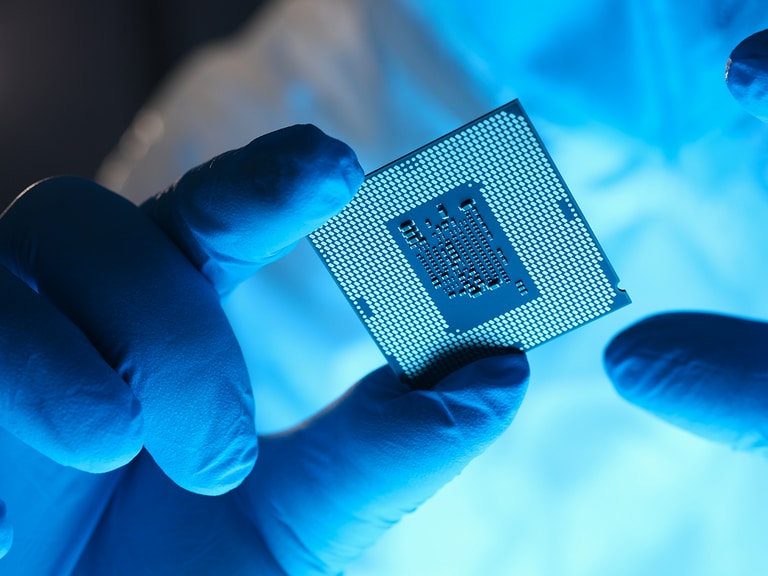Semiconductor stocks have been hit by pandemic supply chain issues, and the Russia-Ukraine conflict is another blow to the industry struggling to keep pace with high demand.
Chip giants like Advanced Micro Devices [AMD], Taiwan Semiconductor Manufacturing Company [TSM] and Nvidia [NVDA] have suffered another blow after Russia’s war in Ukraine halted production of semiconductor-grade neon.
The chip market, which has already been hit by supply chain issues caused by the Covid-19 pandemic, is facing further difficulties as Ukraine’s two leading neon suppliers came to a standstill. The two companies, Ingas and Cryoin, are responsible for 45–54% of all neon used in global semiconductor manufacturing, according to CNBC.
The halt on production could increase the material’s price and worsen the chip shortage. Used in everything from appliances to cars, chips have become the lifeblood of many industries, which has caused a spike in demand.
The iShares Semiconductor ETF [SOXX], which tracks an index of US companies that design, manufacture and distribute chips, fell 10.4% between 24 February and 14 March. Though it has since made back some of this loss, the ETF was down 14.2% year to date at the close on 17 March.
This has had a knock-on effect for the share prices of major producers like AMD and TSMC, which have declined 4.2% and 4.4%, respectively, since the beginning of the invasion.
45-54%
Percentage of world's chipmaker-ready neon gas sourced from Ukraine
Small semiconductor companies more affected
Ukraine supplies the US with more than 90% of its semiconductor-grade neon, while Russia provides 35% of the palladium used in the US for sensors, memory and other applications.
Disruption to supply from Russia and Ukraine will be felt across the global semiconductor industry, but Lita Shon-Roy, president of technology-focused advisory firm Techcet, told Reuters that smaller chipmakers could be hit harder.
“The largest chip fabricators, like Intel [INTL], Samsung [005930.KS] and TSMC, have greater buying power and access to inventories that may cover them for longer periods of time, two months or more,” Shon-Roy said. “However, many other chip fabs do not have this kind of buffer.”
These semiconductor giants have announced plans to build their own chip-making factories to address the supply shortage. Intel announced in January that it would spend up to $100bn to build potentially the world’s largest chip-making complex in Ohio, while Samsung plans to spend $37.7bn this year to expand its chip foundry business.
Inflation could hurt semiconductor stocks
Availability for materials used to make electronic chips is already low, so any further pressure from the Russia-Ukraine conflict is expected to push up prices, which could have a knock-on effect for semiconductor prices.
While chip makers are better prepared for Russia’s invasion of Ukraine as a result of other disruptions, they may need to pass the rising costs onto their customers. Last year, TSMC announced a plan to raise prices on products by as much as 20%. It would be the company’s steepest single increase, and the war could further accentuate price escalation.
After a spike in neon gas prices on 11 March, the commodity has so far petered out. However sustained shortage lingers as a threat. Analysts at ratings firm Moody’s said in a report that during the 2014–15 war in Ukraine, neon prices shot up multifold, causing related products to become more expensive. A similar situation could happen again.
The focus lands on TSMC even as Taiwan said it had anticipated the issue and built adequate reserves to tide it over for the next few months. A commonly discussed corollary to Russia’s run in Ukraine is similar action by China in Taiwan. The sentiment has brought the spotlight of global supply to South Korea’s Samsung, which is the world’s second largest semiconductor manufacturer.
US semiconductor policy
According to the Semiconductor Industry Association (SIA), the US is “vulnerable to supply chain disruptions as it has fallen behind global competition in providing support for this strategic sector” as a result of the pandemic.
The Biden administration’s plans to boost US semiconductor manufacturing and reduce reliance on chip imports. This is likely to be a welcome relief from headwinds for the industry from the Russia-Ukraine conflict.
President Biden said in his ‘Made in America’ address to the nation: “We invented the semiconductor, but we haven’t been making them in America for a long time. We had to import them. We had to wait. It costs more.”
“We invented the semiconductor, but we haven’t been making them in America for a long time. We had to import them. We had to wait. It costs more” - US President Joe Biden
The White House has told chip makers to diversify suppliers in case Russia retaliates against recent US sanctions, and many semiconductor companies are waiting to see whether the tensions will ease.
It is not only the US that is pouring money in the semiconductor industry. In the past several years global governments including China, Korea, and the EU — all major players in the semiconductor industry — have announced the potential for up to $250bn in government investments over the next decade in the chip sector.
Continue reading for FREE
- Includes free newsletter updates, unsubscribe anytime. Privacy policy





